In this NPS case study, we delve into how a leading SaaS company improved its customer retention rates by leveraging the Net Promoter Score (NPS). This case study highlights the context, objectives, and significance of NPS within their customer-centric strategy.
The SaaS industry is fiercely competitive, making customer loyalty crucial for sustainable success. Traditional methods of gauging customer satisfaction often fell short in predicting long-term retention. Enter the Net Promoter Score. By asking clients a simple yet revealing question about their likelihood to recommend the service, the company gained invaluable insights.
This implementation of NPS not only provided a clear measure of customer sentiment but also uncovered actionable data that directly contributed to the SaaS retention success. Here, we outline the journey, strategies employed, and the profound impact on customer retention.
Key Takeaways
- Leveraging NPS can offer deep insights into customer loyalty and satisfaction.
- Effective implementation of NPS helps identify promoters and detractors.
- Actionable feedback derived from NPS can lead to significant improvements in customer retention.
- NPS is an easily deployable yet powerful tool in a SaaS company’s customer-centric strategy.
- Continuous monitoring and adapting based on NPS data are critical for long-term success.
Introduction to Net Promoter Score
Understanding NPS (Net Promoter Score) is crucial for any business looking to enhance its customer loyalty metric. By calculating NPS, companies can gauge the willingness of customers to recommend their services to others—a strong indicator of customer satisfaction and loyalty.
But how exactly do we calculate this valuable metric? The formula is straightforward: we subtract the percentage of detractors (those who rate their likelihood of recommending the business between 0-6) from the percentage of promoters (those who rate it between 9-10). This yields a score ranging from -100 to 100. Businesses strive for higher scores as they signify a larger base of satisfied and loyal customers.
Achieving a deeper understanding of NPS benefits goes beyond just knowing the numerical score. Real-world applications demonstrate that businesses with high NPS often enjoy a range of advantages, including increased customer retention, higher revenue growth, and improved brand reputation.
Moreover, by leveraging NPS benefits, organizations can proactively address customer pain points, fine-tuning their strategies to foster loyalty. The insights gained from NPS can inform decisions across various aspects of a business, from product development to customer service enhancements.
Ultimately, NPS serves as a powerful customer loyalty metric that provides actionable insights, helping companies build stronger, more enduring relationships with their customers.
Background of the SaaS Company
The SaaS industry landscape has become increasingly competitive, prompting companies to develop unique value propositions to stand out. Our profiled SaaS company has carved a niche by offering innovative solutions tailored to specific business needs. Specializing in customer relationship management, the company has built a strong market position through its state-of-the-art tools and customer-centric approach.
Company Overview
This SaaS company, headquartered in India, focuses on providing comprehensive CRM solutions to small and mid-sized enterprises. By leveraging cloud technology, it ensures accessibility and scalability, which are critical components in the current SaaS industry landscape. The company’s innovative approach has attracted a diverse customer base, contributing to its growth and market share.
Challenges Faced
Despite their success, the company encountered significant customer retention challenges. These challenges stemmed from various factors, including evolving customer expectations and increased competition within the SaaS industry landscape. The company observed that maintaining customer satisfaction was not enough; proactive measures were needed to enhance customer retention.
To address these customer retention challenges, the company decided to implement the Net Promoter Score (NPS) system. This decision was influenced by the need to gain deeper insights into customer satisfaction and loyalty, ultimately aiming to mitigate churn rates and foster long-term client relationships.
| Challenge | Description | Impact |
|---|---|---|
| High Customer Churn | Customers were switching to competitors offering newer features. | Increased acquisition costs and reduced revenue. |
| Evolving Expectations | Customer needs and preferences were changing rapidly. | Difficulty in keeping pace and ensuring continuous satisfaction. |
| Market Competition | Numerous competitors with similar offerings. | Price wars and feature-laden offerings putting pressure on the business model. |
Understanding Customer Retention in SaaS
Customer retention is pivotal in the SaaS industry as it directly impacts a company’s long-term growth and profitability. Retaining customers not only reduces churn rates but also ensures a steady revenue stream. When formulating SaaS customer retention strategies, it’s crucial to comprehend both the importance and the key metrics involved in retaining customers.
Importance of Customer Retention
Retaining a customer is typically more cost-effective than acquiring a new one. The closer and longer we maintain our relationship with our customers, the more value we derive from each engagement. This consistent revenue from existing customers can substantially lower acquisition costs, thereby increasing overall profitability. Furthermore, satisfied customers often become advocates, assisting in organic growth by bringing in referral business.
Key Metrics for Retention
Effectively tracking customer retention necessitates understanding critical metrics. Some of the primary retention rate benchmarks include:
- Churn Rate: The percentage of subscribers who discontinue their subscriptions within a given timeframe.
- Customer Lifetime Value (CLV): A prediction of the net profit attributed to the entire future relationship with a customer.
- Net Promoter Score (NPS): Provides insights into customer loyalty by measuring the likelihood of customers recommending the service to others.
By focusing on these metrics, we can better shape our SaaS customer retention strategies, ensuring we are aligned with industry retention rate benchmarks to achieve sustainable growth.
How NPS Was Implemented
Implementing NPS at our SaaS company involved meticulous planning and strategic execution. Our journey began with integrating Net Promoter Score into our existing customer feedback systems.
Initially, we established clear expectations and objectives. Our vision was to leverage NPS as a powerful tool for gaining deeper insights into customer satisfaction. Central to this vision was ensuring a smooth customer feedback collection process, which was pivotal in gathering accurate data.
- Identified touchpoints where customer feedback collection would be most effective.
- Designed comprehensive NPS surveys that were straightforward, encouraging candid responses.
- Integrated survey distribution channels across various platforms to maximize reach.
To ensure the success of NPS, training our staff was essential. We conducted numerous workshops and training sessions, focusing on the importance of NPS and the methodologies involved.
Lastly, setting benchmarks was a crucial part of our process. It allowed us to gauge effectiveness and track progress over time, thereby enhancing our overall survey strategies.
Analyzing NPS Data
To truly understand our customers and drive meaningful change, we utilized advanced methodologies for NPS data analysis. Gathering precise data and translating it into actionable insights were pivotal steps in our journey.
Data Collection Methods
Our primary goal was to collect accurate and comprehensive NPS data. We employed various tools and platforms, such as SurveyMonkey and Qualtrics, to capture customer feedback. Regular surveys were scheduled, ensuring we reached a broad segment of our user base.
Additionally, integrating NPS surveys within our product interface allowed for real-time feedback. This approach also yielded higher response rates compared to email-based surveys.
Interpreting NPS Scores
Once we gathered the data, the interpretation of NPS scores was our next critical step. We classified respondents into Promoters, Passives, and Detractors. By analyzing their responses, we could discern patterns and trends that highlighted our strengths and areas for improvement.
We leveraged statistical tools like SPSS and R for deeper insights. These tools helped us identify correlations between NPS scores and customer demographics, purchase history, and usage patterns.
Customer Feedback Insights
The analysis of open-ended feedback provided a goldmine of actionable insights. By incorporating text analytics tools like NVivo and Google Cloud Natural Language, we could interpret the feedback more effectively. Common themes were identified, allowing us to pinpoint specific pain points and areas that delighted our customers.
For instance, many comments from Promoters emphasized our product’s ease of use, while Detractors often mentioned long customer support wait times. By addressing these concerns, we could make informed decisions to enhance customer satisfaction and ultimately drive retention.
Actionable Strategies Based on NPS Results
After analyzing the NPS data, we’ve devised a responsive action plan to address the feedback we received from our customers. We have categorized our actions into three main areas: business operations, product development, and customer service.
- Business Operations: We realized the need to streamline our processes to better meet customer expectations. Our responsive action plan includes improving our billing and subscription management systems to reduce customer pain points.
- Product Development: Leveraging customer-driven strategy, we have prioritized features that received the highest demand in the NPS feedback. This ensures that our product evolves in line with customer needs.
- Customer Service: We are enhancing our customer support capabilities by implementing a more efficient ticketing system and training our support staff in proactive problem-solving, aligning with a customer-driven strategy.
Customers have expressed a high level of satisfaction due to these targeted improvements, showcasing the effectiveness of our responsive action plan.

| Area | Improvement | Outcome |
|---|---|---|
| Business Operations | Enhanced billing and subscription management | Reduced customer complaints |
| Product Development | Prioritized high-demand features | Increased user satisfaction |
| Customer Service | Efficient ticketing system & proactive support staff | Improved support response times |
These actionable strategies underscore our commitment to a customer-driven strategy, ensuring that our responsive action plan is both effective and aligned with customer needs. By continually refining our approach based on NPS results, we aim to foster long-term customer loyalty and satisfaction.
Comparing NPS with Other Customer Loyalty Metrics
In assessing the different methods used to measure customer loyalty, it’s crucial to recognize the distinctive strengths of each metric. Customer satisfaction, loyalty metrics comparison, and CES vs NPS evaluations offer unique perspectives, helping businesses understand and enhance their customer relationships more effectively.
Customer Satisfaction Score
The Customer Satisfaction Score (CSAT) is a popular and straightforward metric. It typically involves asking customers to rate their satisfaction with a specific product, transaction, or interaction. This metric provides immediate feedback and is useful for pinpointing areas that need improvement to boost customer satisfaction. However, it may not offer a long-term view of overall customer loyalty.
Customer Effort Score
The Customer Effort Score (CES) measures how much effort a customer needs to exert to get an issue resolved, a request fulfilled, or a product purchased/returned. Research has shown that reducing customer effort can significantly improve customer loyalty. The CES is practical and focuses on simplifying customer interactions to enhance their overall experience.
Why NPS Stands Out
The Net Promoter Score (NPS) is exceptional in its ability to capture the broader sentiment of customer loyalty. Unlike CSAT and CES, which may address specific transactions or interactions, NPS asks a simple, yet powerful question: “How likely are you to recommend our company/product/service to a friend or colleague?” This straightforward question helps identify promoters, passives, and detractors, offering a well-rounded view of customer sentiment. The loyalty metrics comparison reveals that NPS not only serves as a reliable indicator of long-term customer retention but also facilitates actionable insights for continuous improvement.
We chose NPS because it aligns well with our strategic goals and provides a comprehensive view that other metrics like CES vs NPS may lack. Its holistic approach allows us to prioritize optimizations that foster customer satisfaction and long-term loyalty.
Improvements in Customer Experience
Our analysis of NPS data revealed several key areas where we could improve the customer experience. By paying close attention to customer feedback, we have made significant enhancements in product features and improved our customer support. These efforts have not only improved satisfaction but also presented us as a leader in support excellence and innovation.
Enhancements in Product Features
One of the major steps we took to enhance the customer journey was updating our product features based on specific user needs. These product feature updates were critical in ensuring that our software remains intuitive, efficient, and in line with user expectations. Features such as real-time analytics, enhanced security protocols, and streamlined user interfaces were prioritized based on the feedback we received from our customers.
- Real-time analytics for better decision-making.
- Enhanced security to protect sensitive data.
- Streamlined user interface for more intuitive navigation.
Customer Support Improvements
Achieving support excellence required a deep dive into the customer service feedback. We restructured our support team to provide faster, more effective resolutions and introduced a 24/7 support option. Additionally, extensive training programs were implemented to ensure our support staff could handle a variety of issues efficiently.
| Support Enhancement | Impact |
|---|---|
| 24/7 Support Availability | Reduced response times and increased customer satisfaction |
| Extensive Staff Training | Improved problem resolution and richer customer interactions |
| Support Restructuring | Faster, more effective customer service |
Impact on Customer Loyalty and Retention
Evaluating the success of our Net Promoter Score (NPS) implementation, we focused on measuring its contribution to customer loyalty and retention. The insights gained allowed us to track the NPS impact on retention, translating into significant benefits for our SaaS company.
Analyzing the data, we observed substantial growth in loyalty increase metrics. This improvement can be directly attributed to actionable insights derived from the NPS feedback.
Customer loyalty experienced a marked improvement, illustrated by an uptick in repeat subscriptions and positive testimonials. Clients expressed enhanced satisfaction with our tailored services and solutions, thanks to the strategic steps driven by the NPS data.
Here’s a detailed comparison of key metrics before and after the deployment of our NPS strategy:
| Metrics | Before NPS | After NPS |
|---|---|---|
| Customer Retention Rate | 65% | 80% |
| Average Customer Lifetime Value | $2,500 | $3,800 |
| Monthly Recurring Revenue | $600,000 | $900,000 |
This compelling data showcases the clear NPS impact on retention, emphasizing the loyalty increase metrics. Our customers’ positive responses and their willingness to recommend our services reflect the improvements in their experience, validating our strategic efforts.
Lessons Learned from NPS Implementation
The journey of implementing Net Promoter Score (NPS) within our SaaS company has been filled with valuable insights. By embracing NPS best practices and focusing on learning from feedback, we’ve managed to drive continuous improvement throughout our organization.
Successes and Failures
Our initial implementation saw several successes:
- Increased customer engagement by regularly soliciting and acting on feedback.
- Enhanced product offerings by directly addressing pain points mentioned by customers.
- Improved team alignment as all departments united under the common goal of boosting our NPS.
However, the process wasn’t without its challenges. We faced some notable failures, including:
- Underestimating the time required to analyze and act on feedback effectively.
- Initial reluctance from some team members who were unfamiliar with NPS best practices.
- Overlooking segment-specific insights that could have provided more tailored improvements.
Key Takeaways
Reflecting on our experience, several key takeaways stood out, guiding us towards successful NPS utilization:
- Prioritize learning from feedback: It’s essential to view each piece of feedback as an opportunity for growth and improvement.
- Implement continuous improvement: Regularly iterate on processes and products based on the insights gained from NPS feedback.
- Engage all stakeholders: Ensure that all departments understand and contribute to the NPS initiative, fostering a culture of collective responsibility.
| Aspect | Successes | Failures | Key Takeaways |
|---|---|---|---|
| Customer Engagement | Enhanced engagement by incorporating feedback | Initial lack of time allocation for analysis | Prioritize understanding and addressing customer pain points |
| Team Alignment | Unified departments under NPS goal | Resistance due to unfamiliarity with NPS practices | Engage all team members in NPS processes |
| Product Improvements | Directly addressed customer pain points | Overlooked segment-specific insights | Focus on continuous improvement and tailored solutions |
Future Plans for NPS Utilization
As we move forward, our focus will be on enhancing the NPS future utilization strategies to ensure better customer interactions and satisfaction. Implementing continuous improvement strategies and upcoming enhancements will be critical in maintaining our competitive edge and fostering long-term customer loyalty.
Continuous Improvement Strategies
To promote continuous customer engagement, we will periodically refine our NPS surveys, ensuring they remain relevant and easy for customers to complete. We plan to integrate more advanced data analytics capabilities to capture deeper insights into customer sentiment and behavior.
- Regularly update survey questions to align with evolving customer needs
- Leverage AI and machine learning for advanced predictive analytics
- Foster a culture of continuous feedback among all departments
The commitment to continuous improvement ensures that our NPS scores are not just a reflection of past performance but a proactive tool driving future growth.
Upcoming Enhancements
In terms of upcoming enhancements, we are planning several strategic initiatives designed explicitly for effective NPS future utilization. These include:
- Enhanced Customer Segmentation
- Real-time NPS Dashboards
- Personalized Follow-Ups
Given these actions, our overarching goal is to maintain a continuous customer engagement cycle that not only captures the voice of the customer but also acts on it promptly and efficiently. We believe that these enhancements and strategies will significantly contribute to higher customer loyalty and retention, underpinning our growth trajectory.
| Improvement Strategy | Expected Impact |
|---|---|
| Regular Survey Updates | Higher Response Rates |
| Advanced Predictive Analytics | Deeper Customer Insights |
| Enhanced Customer Segmentation | Targeted Interventions |
| Real-time NPS Dashboards | Immediate Actionable Data |
| Personalized Follow-Ups | Increased Customer Engagement |
Conclusion
As we conclude our NPS case study, it’s evident that a well-executed Net Promoter Score strategy significantly enhances customer retention outcomes for SaaS companies. The myriad benefits observed throughout the case study include improved customer satisfaction, increased loyalty, and a deeper understanding of customer needs.
Implementing NPS allowed us to gather actionable insights through data collection and analysis, leading to prudent enhancements in product features and customer support. These improvements fostered a stronger rapport with our customer base, ultimately contributing to higher retention rates and a more robust customer experience.
Looking ahead, the continuous focus on customer engagement and satisfaction remains vital. This NPS case study conclusion underscores the importance of staying attuned to customer feedback, iterating on service delivery, and fostering an environment where customer-centricity is at the core of business success. By consistently refining our NPS strategy, we position ourselves to maintain and grow our foothold in the competitive SaaS landscape.
FAQ
What is Net Promoter Score (NPS)?
NPS, or Net Promoter Score, is a customer loyalty metric that measures the likelihood of customers recommending a company’s products or services to others. It’s calculated based on responses to a single survey question and helps businesses gauge overall customer satisfaction and loyalty.
How is NPS calculated?
NPS is calculated by asking customers to rate their likelihood of recommending the company on a scale of 0 to 10. Respondents are classified into three categories: Promoters (9-10), Passives (7-8), and Detractors (0-6). The score is then derived by subtracting the percentage of Detractors from the percentage of Promoters.
Why is NPS important for customer retention in SaaS?
NPS is crucial for customer retention in the SaaS industry because it provides actionable insights into customer loyalty and satisfaction. Understanding customer sentiment through NPS allows SaaS companies to identify areas for improvement, address issues quickly, and enhance the overall customer experience, leading to increased retention rates.
How can NPS surveys help improve customer loyalty?
NPS surveys collect direct feedback from customers, highlighting what they value and where they see room for improvement. By acting on this feedback, companies can make meaningful changes to their products, services, and support, thereby increasing customer loyalty and satisfaction.
What challenges might a SaaS company face with customer retention?
A SaaS company might face challenges such as high churn rates, lack of customer engagement, product-market fit issues, and inadequate customer support. By leveraging NPS, they can gain insights into these problems and develop strategies to address them effectively.
What steps are involved in implementing NPS?
Implementing NPS involves several steps: integrating NPS surveys into current customer feedback systems, educating and training staff on the importance of NPS, setting benchmarks and objectives, and continuously monitoring and analyzing the results.
What are some effective methods for collecting NPS data?
Effective methods for collecting NPS data include email surveys, in-app surveys, SMS surveys, and integrating NPS questionnaires into customer interaction points such as checkout processes or account settings pages. These methods ensure a high response rate and accurate data collection.
How should we interpret NPS scores?
NPS scores are interpreted by classifying respondents as Promoters, Passives, or Detractors and calculating the overall score. It’s essential to consider both the quantitative score and the qualitative feedback provided in open-ended responses to fully understand the customer sentiment and derive actionable insights.
How do we compare NPS with other customer loyalty metrics?
NPS can be compared with other customer loyalty metrics like Customer Satisfaction Score (CSAT) and Customer Effort Score (CES). While CSAT measures immediate satisfaction with a specific experience and CES evaluates the ease of customer interactions, NPS provides a broader view of overall customer loyalty and future business potential. NPS stands out due to its simplicity and direct correlation with growth and profitability.
Related Posts
- NPS and the Impact of Multichannel Support – NPS in Customer Service
- The Role of NPS in Enterprise Customer Experience Strategies – NPS for Enterprise Businesses
- Advanced NPS Analytics: Predicting Customer Behavior
- The Importance of NPS in Insurance Customer Experience – NPS and Financial Services
- Using NPS to Create a Customer Ambassador Program – NPS for Customer Advocacy and Loyalty
- How Tesla Uses NPS to Improve Customer Experience
- How NPS Can Help Validate Customer Feedback Trends – NPS and Customer Feedback Systems
- Creating Products that Promote High NPS Scores – NPS and Product Development






